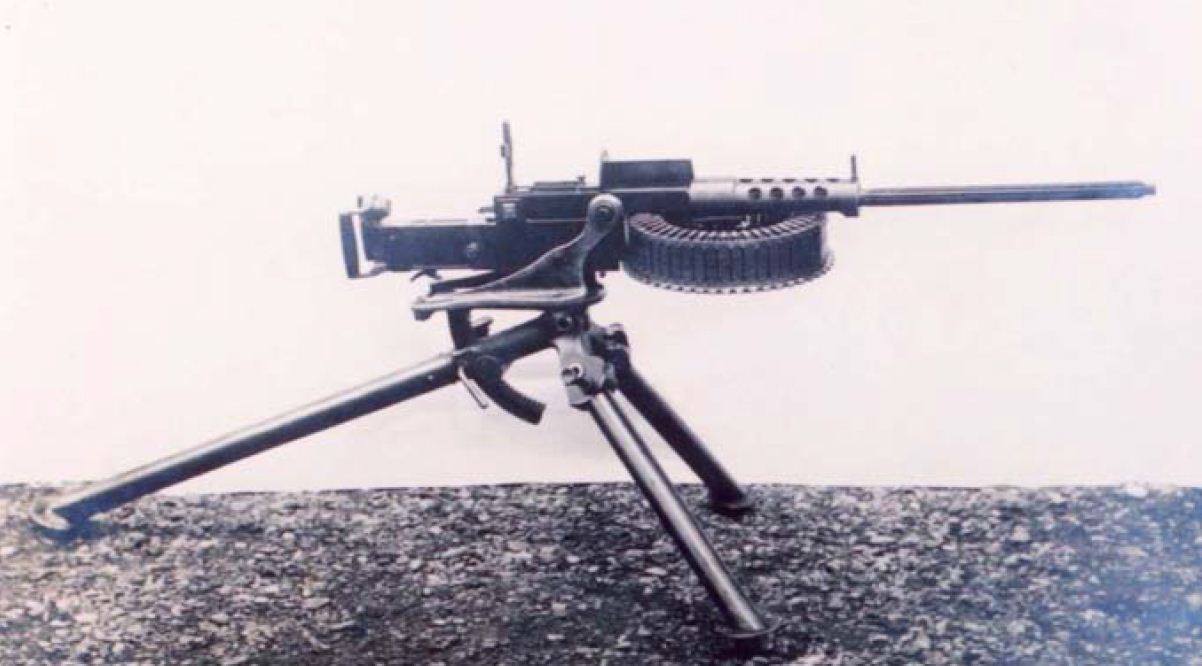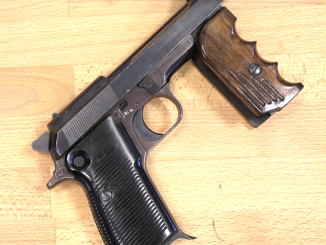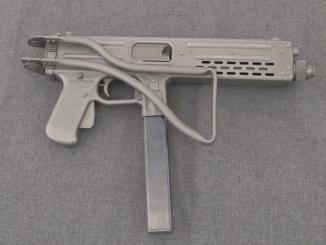The Breda Model 37 was Italy’s standard heavy machine gun (which meant a rifle-caliber gun fired only from a tripod) during World War Two. It was chambered for the 8x59mm cartridge, as Italy used a two-cartridge system at the time, with 6.5mm for rifles and the heavier 8mm for machine guns to exploit their longer effective range. Production began in 1937 and continued until the end of the war, with a batch being made for German use after the Italian armistice in 1943. Pre-war it was also sold to Portugal as the m/938. It remained in Italian use after the war as well, eventually replaced by the MG42/59.
The Breda 37 is a durable, reliable, and overall very good design. It uses 20-round feed strips, with the quite unusual feature of placing fired cases back into the strips rather than ejecting them out of the gun. It is a relatively unknown gun today, but this is not because of any inferiority on its part.
Breda PG rifle:
Fiat-Revelli Modelo 1914 HMG:




The 8 x 59mm cartridge was officially the “8.59” in Italian Army designation. Exactly why, nobody seems to know.
The cartridge had roughly the ballistics of the British .318 Rimless Nitro Express big-game round, with a 210 grain FMJ at 2,600 F/S for 3,160 FPE at the muzzle. Making the Breda Mo37 a true heavy machine gun, with greater “reach” and hitting power than any “standard rifle-caliber” gun. Its closest analogue in military use was the Swedish 8 x 63mm Mauser (218 @ 2,493 for 3,025).
In the Western Desert campaign, the British LRDG cheerfully used any Mo37s and ammunition for same they could acquire, often mounting the gun on the back of the Chevrolet 10cwt “India Pattern” truck that became so identified wit them. Next to an Italian Breda 20mm AA gun or a Browning .50, the Mo37 was the heavy hitter in their “golf bag”, able to punch through the engine block of most scout vehicles and etc. out to 1,000 yards.
Today, armies could do a lot worse for support MGs than reviving the concept of the Mo37. The .408 CheyTac (10.6 x 77mm) or .338 Excalibur (8.58 x 76mm) might be good choices for the cartridge.
clear ether
eon
The Sig MG338 is arriving in service with SOCOM, using the Norma .338 Magnum cartridge.
“(…)closest analogue in military use was the Swedish 8 x 63mm Mauser(…)”
Now I am extremely confused. To my understanding Swedish forces used 8 x 63 mm named patron m/32 which was developed by Aktiebolaget Bofors. Can you provide source claiming that said cartridge was actually developed by Mauser Werke?
Around 1970 I contacted Bofors in this matter. In the kind response letter they stated having not been involved in the development of the 8 x 63 cartridge.
I agree that Mauser was not invoved either. In the 1890s, Norway and Sweden managed the joint development of the 6.5 x 55 on their own. I do not think that in the 1930s any foreign support was needed for the long range MG cartridges.
Norway and Sweden were one country until 1905
“One country” is a little oversimplifying. As a matter of fact, there existed a “personal union”: both had the same king, but many institutions were separate, including the armies. Norwegian army used the 6.5 mm cartridge in its Krag-Jörgensen rifle, the Swedish Army used the 1896 rifle designed by Mauser.
Growing nationalism resulted in the separation of 1905 you mention.
There is also the little known 7.92X61mm Norwegian, used on the Colt M/29 MMG (Issued MMg of the Norwegian Army in WWII), whose performances were identical to those of the 8X63mm Swede (same bullet weight at the same speed). It’s evident one copied the homeworks of the other.
Here’s one next to a 7.92mm Mauser.
https://global.discourse-cdn.com/business6/uploads/cartridgecollectors/original/2X/c/c22dbf97204d9c1ca23b7b3b57a6e28aecde20bc.jpg
“(…)20-round feed strips(…)”
Observe that whilst cloth belts for machine gun produced some moisture-related issues, Italian FIAT-Revelli Modello 1935 was according to
…(using non-desintegrating steel belts)…
Before that weapon Breda manufactured Mitragliatrice Antiaerea “Breda” calibro 13.2mm Tipo R. Marina https://modernfirearms.net/en/machineguns/italy-machineguns/breda-m1931-2/
it used stick magazines, however was mainly made for naval use (used as armament of submarines). To my understanding it was license version of Mitrailleuse Hotchkiss de 13,2 mm, which has magazine and strip version, which lead to question if Italians bought licenses for both or only former?
Addendum: quote is missing link which should be http://modernfirearms.net/en/machineguns/italy-machineguns/fiat-revelli-m1914-m1935-eng/
Here some picture of the belt.
https://cesimmunizioni.eu/forum/download/file.php?id=21958&sid=466b90f262ea36e08d0605e36e3406e5
https://cesimmunizioni.eu/forum/download/file.php?id=21957&sid=466b90f262ea36e08d0605e36e3406e5
https://cesimmunizioni.eu/forum/download/file.php?id=21956&sid=466b90f262ea36e08d0605e36e3406e5
And of the belt in pristine conditions, along with many info on the cartridge (in Italian)
https://cesimmunizioni.eu/doc/8x59RBricci.pdf
The belt was pretty well thought, but also pretty stiff.
https://www.youtube.com/watch?v=pWesu9pA6Ro
From the serial number, it’s the same weapon.
So the box and the tray loader-unloader should be included.
“Factory .408 CheyTac ammunition is expensive, starting at around $7 per round with Jamison International 419-grain (27.15 g) very-low-drag projectiles.” One assumes .338 Norma mag is cheaper; 7 bux a round, in full auto.
Sounds expensive… Mind, suppose if it works. Mind you, given .338 Norma being apparently adopted; I would be surprised if that was 8 bux or 7 dollars and 25 cents etc, per round. Anyone know?
“(…)CheyTac(…)”
Be warned that according to https://guns.fandom.com/wiki/.408_CheyTac
Jamison International has been, up until recently, the primary producer of the 419-grain projectile that is the patented ‘CheyTac’ cartridge.
therefore part of price might be effect of said patent.
How much is 8x59mm ww2 Italian standard to knock up like? .338 Norma sounds expensive also, for it’s purpose. Very expensive all this modern gear isn’t it, I mean in full auto; folks will probably miss lots of shots, so like 8x59mm I mean it is basically upon an actual impact doing more or less… Less than .50Bmg more than 7.62 Nato. I mean if you are shooting Commie Chinese folk these prices are going to become astronomical.
And astronomic prices do not win wars; against folk with similar amounts of cash/tech etc… Especially if there are 4 x more of them eh. 7 dollars a round, think on.
Seems to me very much aimed at previous issues in Afghan that; the need for rifles to have a bit more reach. Well forget that “A” Taliban are back in charge.
“(…)7 dollars(…)”
To carry on war, three things are necessary: money, money, and yet more money. – Gian Giacomo Trivulzio
“(…).338 Norma sounds expensive (…)”
To my understanding it was designed for competition shooting, where high precision is must. It should be possible to develop load for machine gun, where such precision is not providing much advantage, better suited for mass production. Independently from that bigger size production should result in lowering unit price.
Amen to that.
Ian Hogg, in his book about WWII weapons, claimed this gun putthe empty cases back in the feed strips, perhaps “for maximum tidiness on the battlefield.” His tone was dismissive. Though it does seem to me, in hindsight, that there are advantages in not having an ejection port and in not spewing spent cases around where the enemy might spot you.
Yes good point, say the enemy got to your previous spot saw aload of dumped brass and said ah here… Lets move incase they shell it. They might think oh wow what a great spot nobody has thought of that; then you can shell your last position. Or such?
Hmmm, anyway interesting mechanism that overall. Tidy and whatnot. Save brass etc. Unusual. Idea.
It’ seems that, every time something works slightly differently than the way people are used to, then: or it must lead to dire consequences, or it has to have some strange and amusing reason you can look down to, or it must be some sort of unnecessary and expensive overcomplication.
All three kind of biases had been applied to this weapon by various reviewers.
For the first, you can easily find descriptions and comments on the poor soldiers that had to unload and recharge the strips under enemy fire (like the crew of a belt-fed MG was supposed to reload spent belts under enemy fire).
For the second, see the “need to retrieve brass” or “need to keep the position tidy”.
For the third, see the descriptions of the “complicate mechanism that reinserted the spent brass in the tray” written by many people that had never seen that mechanism.
The reason the Breda 37 reinserted spent cartridges in the tray was that it was simpler that way, then the weapon had an opening less, that meant less dirt and stronger receiver.
I think this design to put empty cartridge cases back into the belt comes from the italian Great War experience of mostly fighting in the Alps. Up in the mountains space is very cramped and brass littering the ground is a dangerous hazard that can make soldiers slip and fall. Maybe they also thought of aircraft use and ground vehicles too to not have tue empty casinga flying around everywhere.
Looking at the rest of the world; might be an idea to just belt out a few thousand of these with the appropriate few billion rounds etc. 14.5mm is Heavy, 12.7mm could be made lighter… Pump out shit loads of lighter .50bmg’s also; point being always have something to potentially restrict 14.5mm “Apart from the usually shit operators” but Commie China, might have shit loads of expert Ninja type 14.5mm operators.
Anyway War eh, what a stupid idea; who came up with that? “Ok he/she had not heard of guns/bombs etc.” so point remains; bit thick that really as a course of action. Should, really… Really. Aye, really think – Prior. But nobody does.
“(…)expert Ninja type 14.5mm operators(…)”
What is this?
Yee haw kung fu… I don’t know; drunk, suppose a bigger population… More kung fu ninja type 14.5mm operators than Russia with a smaller population.
Yeee haw… Cowboy drunk… Hi ya! Is it “Ninja” type noise.
Robot 14.5mm operators, all to look forward too. He he.
My father’s generation would have disagreed with you!
The Breda 37 was NOT reliable – it was prone to jamming in the Desert Wars of WWII due to poor extraction.
It needed lubricated ammo, but, that led to further problems, during long engagements.
The Italian soldiers morale was not helped by their poor MMG and LMG.
It is likely that the poor morale of the Italians was contributed to by their poor LMGs and MMGs.
If either were any good the LRDG and SAS would have scrounged them from the battlefield. Where they’d jammed and were left behind.
Like most Italian MG’s extraction was not as reliable as the Vickers MMG.
You are mistaking the Breda 37 with the Breda 30.
Not only the Breda 37 didn’t “need lubricated ammo”, but the manual specifically advised the gunners to NOT lubricate them. It was also considered to be extremely reliable, other than easy to disassemble and service, and the “tactical and technical trend” (the magazine of US intelligence) No. 23, April 22, 1943 deemed it to be “excellent”.
The Brits and especially the LDRG, used any of them they could put their hands on. But that’s true for the Breda 30 also.
https://i.pinimg.com/originals/f8/d5/59/f8d55949a95a21f18f095745def2e074.jpg
The only Italian weapon the Brits didn’t use was the Carcano rifle, since there was no shortage of bolt action rifles.
Italian WW2 fighter aircraft retained their spent brass cartridges in tanks that were then emptied once the aircraft landed. As opposed to the spent cartridges simple being ejected into the slipstream while flying.
My understanding is that brass was regarded as a strategic resource by the fascist regime, hence it was recycled where possible.
I too had read the theory that the Breda’s odd way of replacing the used brass was to keep it from getting under the feet of men in tanks, but this does not appear to be so. It seems there are two good reasons for it, first to keep the brass for reuse, and second to keep the number of openings in the gun down to two. Both make sense, as Italy was not a rich country and had to husband resources, and also operated in dusty and sandy areas, so what seems at first sight bizarre is actually quite well thought out.
I would query Ian’s comments that the Breda was akin to the Browning M1919A4. The Breda is a heavy, crew served gun, to be used in fixed emplacements, as Ian said. The M1919A4 was described by the US Army as a light machine gun, and was meant to be very mobile. The gun the Breda would have matched in the American order of battle would surely have been the Browning M1917.
For the use of the Breda 37 on the field, both on fixed position and on the assault, one must read “The Sergeant in the Snow” by Mario Rigoni Stern. During the retreat from the Don river, subsequent to operation Little Saturn, and the final battle to break through the pocket at Nikolayevka, he operated a Breda 37.
Throughout the text you always had the impression “the heavy one” was the valuable piece of equipment of the platoon. The one that decided the outcome of the numerous clashes it had during the retreat.
During the final battle, entered in a “izba”, they placed the gun on the dining table and fired through the window on the Russians at 100m distance.
Italian movies from that era regarding said machine gun
On assembly line https://www.youtube.com/watch?v=A4ZPfVmSN9E
In use https://www.youtube.com/watch?v=D8nBcS8X1yw
Note that voice in 2nd claims it is Modello 36, it also show this weapon in AA configuration. After investigating further I found interesting data at https://www.lsb-malta.com/en/articles-news/news/38/metralhadora-pesada-792-mm-m938-breda.htm
That this weapon was firstly adopted by Regia Marina in 1936 and it was used in action by X Flottiglia MAS which to my understanding it was elite unit of Regia Marina, suggesting said weapon was considered really good.
Also Breda Modello 37 spawned Metralhadora pesada 7,92 mm m/938 Breda which consumed 7,9×57 cartridges and was used by Portugal as late as their colonial wars (1961…1975) again suggested it was good enough to keep, even considering flow of surplus machine-guns following end of WWII.
You can see the ammo box in the clip states “Breda 36”, like this one (300 ammos, so 15 strips). https://i.postimg.cc/VN7yyC1n/s-l1600.jpg
Later manufactured boxes had been corrected to Breda 37.
https://upload.forumfree.net/i/fc5860349/20210712_123942.jpg
Those were “backpack” boxes
https://upload.forumfree.net/i/fc5860349/20210712_124016.jpg
Later, they had been replaced by “bag” boxes of the same capacity, the ammo bearer was evidently supposed to carry two of them. https://www.tuttoexordinanza.it/bmz_cache/8/80c7ac2749ab017a611c35e4fd24956f.image.340×500.jpg
https://www.tuttoexordinanza.it/bmz_cache/b/bd29146fc70b2bfad85830ed557b8981.image.451×500.jpg
I’ve always suspected that the reinsertion trick was copied from the Hotchkiss MGs, which also fed from 25-round strips and had that setup on several models.
Some like the Hotchkiss Portative and the American Benet-Mercie’ Model 1909 (basically the same as the “Portative” except in .30-06 instead of 8mm Lebel) had to have the strip inserted with the cartridges on the underside instead of on top. So with those, RTFM was even more important than usual.
clear ether
eon
The 13.2mm Breda M31, licence production Hotchkiss M29, had been the first gas action manufactured by Breda.
Almost at the same time (also 1931), they developed the rising bolt action (different from the Hotchkiss tilting bolt action) for the Breda PG (that used a sort of “Bang” system. Sort of because it had the annular piston, but also four gas ports into the barrel to actuate it).
Then they coupled the Breda PG rising bolt with an Hotchkiss-style gas piston to obtain the 37mm Breda 37/54 (1932, top-fed), 20mm Breda m20/65 (1935, strip-fed), 8mm Breda M37 and M38 (1937-1938 strip and top fed), that were scaled versions of the same weapon.
It’s quite impressive how Breda passed from nothing to a complete array of gas-operated weapons, from 6.5 automatic rifle to 37mm AA automatic gun, in something like 7 years.
Correction, the 37mm Breda 37/54 was strip fed, sorry.
“(…)RTFM(…)”
I am not sure if that will explain why reinsertion was present. I think whyabout might be unveiled by patent. Sadly I was unable to find patent relevant for Breda Modello 37.
To me the answer is “why not?”.
It wasn’t complicate and it had some advantage. Even if only to spare an opening in the receiver.